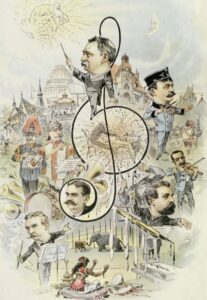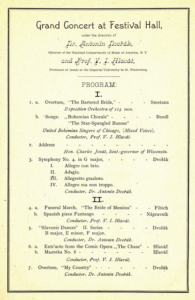Module 2: Dvořák as Otherer
 Module Introduction
Module Introduction
Dvořák’s arrival in New York was surrounded by expectation both on the part of the composer and by the American music community. For Dvořák, stepping into the “New World” offered an opportunity to experience in reality what he (like many Europeans) had read about the continent in novels and newspapers. For the musical community in the United States, the composer’s arrival promised a connection between the European symphonic tradition and local compositional developments that were steeped in anxieties about whether there could be a music representing the American nation. Both shared concepts of these territories, cultures and populations, and both evinced the certainty that music would, and could, connect them.
These anxieties about a national music were expressed by the critic Henry Krebiehl who envisioned Dvořák as a mentor to, and an inspiration for, American composers – one whowould create a new symphonic sound. For Krebiehl, “aboriginal peculiarities of rhythm or melody,” or folk-songs, would be the ingredient with which to adapt Dvořák’s recipe to the continent. This formula of using the music of communities from the country-side turned out to be one of the main compositional strategies of Dvořák’s Symphony no.9 (From the New World), first performed in New York on December 15, 1893.
The subtitle of the symphony, From the New World, sets the music within a specific geographical location and suggests a perceptible relation to the source of these sounds. Dvořák’s efforts to use themes arising from his imagination of the territory mediated by books and his listening to the music while being there suggests issues of authenticity and appropriation, all the more as his concept of America was both mediated by books and garnered through selective listening after his arrival in New York. This module engages with Dvořák’s use of American communities and their musics, specifically racialized and indigenous populations, as one example of the representation of Otherness in a symphony.
“The Song of the Hiawatha”
In 1855, the epic poem “The Song of the Hiawatha,” was published in the United States and became an instant best-seller. Written by Henry Wadsworth Longfellow (1807—1882), a White poet born in Maine, who taught English at the Harvard College in Massachusetts, the book was quickly translated into several languages, including a Czech version in 1872. The poem is centered on Native American characters, in particular the Ojibwe warrior Hiawatha, and tells the story of his love for the Dakota woman, Minnehaha. Longfellow drew his inspiration for the narrative and form from two other works: Henry Rowe Schoolcraft’s Personal Memories of a Residence of Thirty Years with the Indian Tribes of the American Frontiers: With Brief Notices of Passing Events, Facts, and Opinions, A. D. 1812 to A. D. 1842, and Elias Lönrrot’s Finnish epic Kalevala (1835/1849). Despite references to oral histories of the Native American groups incorporated to the narrative (that include some uncredited knowledge of Native American sources from Schoolcraft), some readers of the poem criticize its free use of the stories by Longfellow. Nevertheless, the commercial success of the book and its circulation across the world created images not only of Native Americans but also about America that shaped the way in which both Americans and readers elsewhere in the world imagined the continent.
One of the readers abroad was Czech composer Antonín Dvořák. As the musicologist Michael Beckerman states, Dvořák “fell under the spell of the Hiawatha,” even before his travel to the “New World.” Jeannette Thurber, the patron of Dvořák’s enterprise in America, gave to the composer an English copy of the book upon his arrival to the country. The press speculated about a possible opera project based on the story. As Dvořák mentions in an interview on the day of the first performance of his Symphony No. 9 From the New World, the poem is echoed in the second and third movements of the work (see Primary Sources). The press expanded on Dvořák’s comments including not only references to the poem but also to Native American sounds. Although Dvořák had interest and the chance to meet indigenous populations in the United States, there is no evidence that he engaged with their sounds in his compositions.
Listening to Spirituals
During his period teaching at the National Conservatory of Music of America, Dvořák was able to listen to musical traditions different from his homeland and incorporate them in his own compositions. Initiated by Jeanette Thurber, the Conservatory supported a project of promoting African American musical practices by including it under a proposal of a national music. The institutions gave access to musical training for exceptional students of color and offered a way to include them in this national project (see Primary Sources). One such student, Harry T. Burleigh, remembers singing songs of African American tradition for Dvořák. Burleigh also states that Dvořák “filled himself with the spirit of the old Spirituals,” even before composing his own themes, including a direct reference to Swing Low, Sweet Chariot in the first movement of the Symphony. Different from the symphonies of African American composers such as William Grant Still’s Symphony no. 1 “Afro-American” and Florence Price’s “Juba Dance” from her Symphony No. 1 that directly refers in their compositions to a racial inspiration, Dvořák’s Symphony No. 9 acknowledges the territory from an explicitly foreign perspective (From the New World) that does not explicitly recognize race.
Primary Sources
Excerpt of New York Herald, December 16, 1893.
Horowitz, Joseph. “Dvořák and Boston.” American Music 19/1 (2001): 3-17.
Whoever it was, he seemed modestly to wish to remain at the back of the box on the second tier. At last a broad shouldered individual of medium height, and as straight as one of the pines in the forests of which his music whispered so eloquently, is descried by the eager watchers. A murmur sweeps through the hall. “Dvořák! Dvořák!” is the word that passes from mouth to mouth…. With hands trembling with emotion Dr. Dvořák waves an acknowledgement of his indebtedness to Anton Seidl, to the orchestra, to the audience, and then disappears into the background while the remainder of the work goes on…. At its close the com- poser was loudly called for. Again and again he bowed his acknowledgements, and again and again the applause burst forth. Even after he had left his box and was walking about in the corridor the applause continued. And finally he returned to the gallery railing, and then what a reception he received! The musicians, led by Mr. Seidl, applauded until the place rang again.
Excerpt of “Real Value of Negro Melodies,” New York Herald, May 21, 1893.
Music in the USA, edited by Judith Tick. 311—312.
The National Conservatory of Music of America, 126 and 128 East Seventeenth Street, New York, May 16, 1893
The National Conservatory of Music of America proposes to enlarge its sphere of usefulness by adding to its departments a branch for the instruction in music of colored pupils of talent, largely with the view of forming colored professors of merit. The aptitude of the colored race for music, vocal and instrumental, has long been recognized, but no definite steps have hitherto been taken to develop it, and it is believed that the decision of the Conservatory to move in this new direction will meet with general approval and be productive of prompt and encouraging results. Several of the trustees have shown special interest in the matter. Prominent among these is Mrs. Colus P. Huntington. Tuition will be furnished to students of exceptional talent free of charge. Two young but efficient colored pupils have already been encouraged as teachers and others will be secured as circumstances may require. Application for admission to the Conservatory classes is invited, and the assignment of pupils will be made to such instructors as may be deemed judicious. Dr. Antonin Dvorak, director of the Conservatory, expresses great pleasure at the decision of the trustees, and will assist its fruition by sympathetic and active cooperation. May I ask you to place these facts before your readers and in favoring a worthy cause once again oblige yours, very truly.
JEANNETTE M. THURBER, President
Secondary Sources
Beckerman, Michael. “Dvořák’s “New World” Largo and “The Song of Hiawatha”.” 19th-Century Music 16/1 (1992): 35-48.
Burleigh, Harry T. “The Negro and His Song,” in Music on the Air, ed. Hazel Gertrude Kinscella. New York: Viking, 1934: 186–89.
Horowitz, Joseph. “Dvořák and Boston.” American Music 19/1 (2001): 3-17.
Tick, Judith and Paul Beaudoin (ed.) Music in the USA: A Documentary Companion. New York: Oxford University Press, 2008.
Nurmi, Tom. “Writing Ojibwe: Politics and Poetics in Longfellow’s Hiawatha.” The Journal of American Culture 35/3 (2012): 244-256.
Shadle, Douglas. Antonín Dvorak’s New World Symphony. New York: Oxford University Press, 2021 (forthcoming).
Investigations
1) In 1893, Chicago hosted the Columbian World’s Fair which celebrated the four-hundredth anniversary of the “discovery” of the Americas by Christopher Columbus. The 1893 World’s Fair gathered millions of people interested in seeing the pavilions that included representation of cultures from all around the world, from indigenous populations that lived not far from the area to distant “exotic” groups of faraway colonies. One of the visitors of the exhibition was Antonin Dvorak, who conducted a concert in tribute to the Bohemian Day on August 12, 1893.
Source: Chicago Symphony Orchestra Archives. <https://csoarchives.files.wordpress.com/2016/07/dvorak-1893-b.jpg>
Several of the artifacts and objects that Dvorak and other visitors saw at that exhibition gave origin to the collection of Chicago’s Field Museum, which lists as its mission to fuel “a journey of discovery across time to enable solutions for a brighter future rich in nature and culture.”
Explore the collection of the museum from their blog and catalogue (provided in the links bellow) and answer the following questions in connection to the texts on Dvorak.
Field Museum’s resources on the 1893 World’s Columbian Exposition
- By seeing the collection of objects from the exhibition (including fossils, animals, and art from different cultures) how would you describe the communities represented in the exhibition?
- By listening to Dvorak’s Symphony no. 9 (From the New World) that takes inspiration from North American communities, how is Dvorak’s representation of the sounds of these groups different from the museum?
- In the twentieth-first century, what are the ethics involved in exhibiting these works and playing this symphony?
2) As you have read in the text of this module, since before its completion, critics announced Dvorak’s inspiration from Native American music in the composition of his symphony. The musicologist Michael Beckerman writes about some different ways in which the second movement of the work, the Largo, is possibly connected to the chapter of Longfellow’s “The Song of the Hiawatha,” named “Hiawatha’s Wooing.” Read this chapter of the poem (available in the link bellow) and complete the following instructions.
Henry Wadsworth Longfellow, “Hiawatha’s Wooing” from “The Song of the Hiawatha”.
- Write down the names of the ethnic tribes represented in the poem (tip: the names are referred to their relationship with their lands).
- Using this digital map < https://native-land.ca/> find the territories that belonged to the tribes named in the poem. Write down the names of the modern states settled in these territories.
- Do your own research on these Native American populations and learn more about their history and culture (you can find YouTube videos that provide good introduction that include examples of their uses of sound). What aspects of these cultures are used by Longfellow and Dvorak? What aspects of their culture were ignored or misrepresented in the poem and the symphony?

